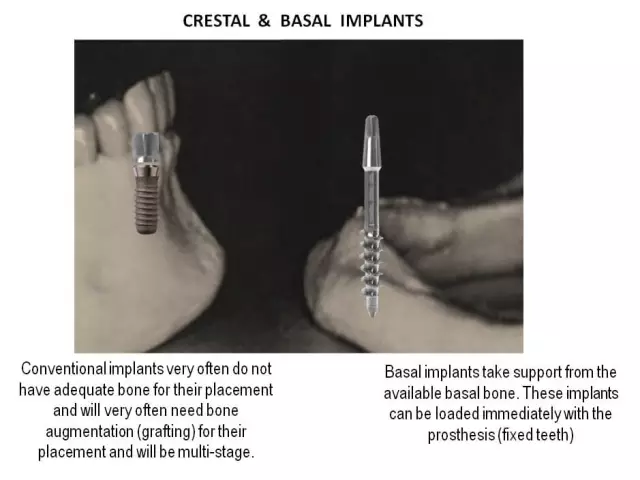- Author Rachel Wainwright [email protected].
- Public 2023-12-15 07:39.
- Last modified 2025-11-02 20:14.
High-quality basal dental implantation
Dental implants are one of the most popular procedures performed in dental clinics. New methods of operations are being developed. This is due to the fact that in terms of prevalence, implantation is in no way inferior to the treatment of caries and periodontal disease.
One of the modern methods is basal implantation, the price of which is at an acceptable level, comparable to other methods, but its advantage is that all work is carried out in a short time. It is believed to be one of the least traumatic methods.

Basal implant types
At the moment, dentists distinguish 4 types of implants:
- disk;
- modern basal implants;
- compression;
- zygomatic.
Each type is installed in specific cases. The dentist first examines the oral cavity and makes a decision on a case-by-case basis. At the same time, disk implants are practically not used anymore, since there is a high risk of injury, and it is rather difficult to predict their effectiveness.
Modern implants are unified structures that are implanted deep enough into the bone. Their installation takes a little time from an experienced doctor. Zygomatic implants are the solution for those who need upper jaw prosthetics. They are implanted into the cheekbone.
Features of implantation
This technology provides for a one-stage operation with immediate loading. This makes it possible to reduce the patient's rehabilitation period, as well as to significantly reduce the price compared to other methods. But it is important that the dentist correctly considers the choice of the method of prosthetics and selects the optimal one, in each specific case.
The essence of basal implantation is that chewing function is immediately restored after a dental procedure. For attachment, the jaw or zygomatic bones, as well as the lines of force of the skull, can be involved.

Prosthetics takes place 2-3 days after the operation. In the classic two-step method, you have to wait from 2 to 5 months. That is why this method is now gaining more and more popularity.
A similar variant of prosthetics is prescribed for patients where it is not possible to install a prosthesis using classical methods, for smokers, for chronic periodontal diseases, and also if the patient is elderly.
One of the main contraindications is considered to be malignant tumors in the head and neck region, as well as a number of bone tissue pathologies. This procedure will not be performed for cardiovascular diseases, tuberculosis and mental disorders.
Stages of basal prosthetics
Any dental procedure is carried out in several stages. Initially, it is necessary to come to the dentist, who will examine the oral cavity, X-ray examination, and also identify indications and contraindications.
At the second stage, computer modeling is carried out, which will show the state of the bone. This will start creating the surgical template. This approach will make the prosthetics more accurate.
This is followed by the operation. Soft tissues will be punctured, and the process of implantation of implants must be performed with all the changes that will be identified during the procedure. X-rays are not able to accurately indicate the structure of the bone, so you have to build on what information the dentist receives during the procedure.
At the last stage, impressions are taken. After that, the prosthesis is installed within three days. Thus, the entire operation will take several days, after which chewing function will be restored immediately. In addition, the stability of the entire jaw is restored.
Source of information: Dental Implant Center, Smile-Estet Dentistry.
Found a mistake in the text? Select it and press Ctrl + Enter.






